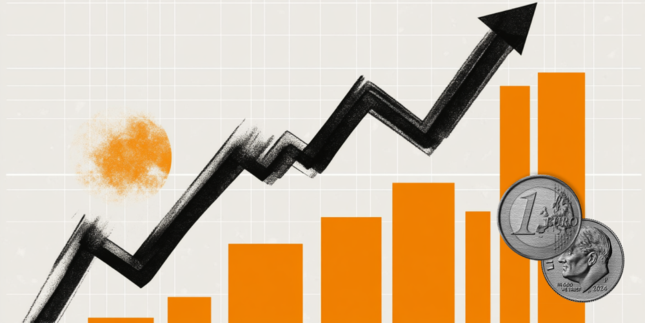- EUR/USD struggles to build on modest intraday gains to a multi-day top, despite a softer USD.
- A fresh leg down in the US bond yields undermines the USD and lends support to the major.
- The upside remains capped as traders now keenly await this week’s crucial inflation figures.
The EUR/USD pair retreats a few pips from a three-day top touched during the mid-European session on Tuesday and currently trades around the 1.0850 region. The downside, however, remains cushioned in the wake of diminishing odds for rapid rate cuts by the European Central Bank (ECB). Apart from this, a modest US Dollar (USD) downtick is seen as another factor acting as a tailwind for the currency pair.
That said, the darkening Eurozone economic outlook held back traders from positioning for any further gains for the shared currency. Moreover, growing acceptance that the Federal Reserve (Fed) will keep rates higher for longer helps limit losses for the USD and contributes to capping the EUR/USD pair. Investors also prefer to wait for this week's releases of crucial inflation data from the Eurozone and the United States (US).
The flash CPI estimates from Germany, France and Spain are due for release on Thursday, which will be followed by the US Personal Consumption Expenditures (PCE) Price Index. Apart from this, Friday’s closely watched Eurozone inflation data will play a key role in influencing the shared currency and provide some meaningful impetus to the EUR/USD pair ahead of the upcoming ECB policy meeting on March 7.
Daily digest market movers: Lacks firm intraday direction amid mixed fundamental cues
- The recent hawkish comments by European Central Bank (ECB) policymakers, suggesting that the central bank shouldn’t rush into a decision to cut interest rates, continue to underpin the shared currency.
- ECB President Christine Lagarde told lawmakers that wage pressures remain strong across the region and are anticipated to be an increasingly important driver of inflation dynamics in the coming quarters.
- Lagarde added that there are increasing signs of a bottoming-out in growth and some forward-looking indicators point to a pick-up later this year, pushing back market expectations for early interest rate cuts.
- The yield on the benchmark 10-year US government bond remains depressed near 4.275%, which is seen undermining the US Dollar and lending additional support to the EUR/USD pair on Tuesday.
- A looming recession risk in Germany – the Eurozone's largest economy – keeps a lid on any further gains for the Euro amid expectations that inflation is moving back towards the ECB’s 2% annual target.
- The FOMC meeting minutes released last week, along with several Federal Reserve officials, suggested that the US central bank will keep rates higher for longer amid sticky inflation and a resilient economy.
- Traders now look to the US macro data – Durable Goods Orders, the Conference Board's Consumer Confidence Index and the Richmond Manufacturing Index – for short-term opportunities on Tuesday.
- The focus, however, remains glued to this week's release of the closely-watched flash Eurozone consumer inflation figures and the US Personal Consumption Expenditures (PCE) Price Index.
Technical analysis: EUR/USD bulls have the upper hand, 1.0800 mark holds the key
From a technical perspective, the overnight close above the 200-day Simple Moving Average (SMA) and the subsequent move up favours bullish traders. Moreover, oscillators on the daily chart have just started gaining positive traction, suggesting that the path of least resistance for the EUR/USD pair is to the upside. That said, it will still be prudent to wait for some follow-through buying beyond the 1.0865 region, or the 38.2% Fibonacci retracement level of the December-February downfall before positioning for any further gains. Spot prices might then surpass last week's swing high, around the 1.0885-1.0895 region, and aim to test the 50% Fibo. level, around the 1.0920 zone. The momentum could extend further towards reclaiming the 1.1000 psychological mark for the first time since January 11.
On the flip side, the 200-day SMA resistance breakpoint, around the 1.0830-1.0825 region, now seems to protect the immediate downside ahead of the 1.0800 mark. The latter coincides with the 23.6% Fibo. level, which if broken decisively will negate the positive outlook and make the EUR/USD pair vulnerable to accelerate the fall towards the 1.0770-1.0765 area. Spot prices could eventually drop to retest sub-1.0700 levels, or a three-month low touched on February 14.
Euro price this week
The table below shows the percentage change of Euro (EUR) against listed major currencies this week. Euro was the strongest against the New Zealand Dollar.
| USD | EUR | GBP | CAD | AUD | JPY | NZD | CHF | |
| USD | -0.34% | -0.15% | -0.09% | 0.15% | -0.14% | 0.22% | -0.22% | |
| EUR | 0.34% | 0.19% | 0.25% | 0.48% | 0.19% | 0.57% | 0.12% | |
| GBP | 0.15% | -0.20% | 0.05% | 0.28% | -0.01% | 0.37% | -0.08% | |
| CAD | 0.10% | -0.25% | -0.06% | 0.24% | -0.07% | 0.32% | -0.13% | |
| AUD | -0.15% | -0.48% | -0.28% | -0.23% | -0.27% | 0.09% | -0.38% | |
| JPY | 0.16% | -0.18% | 0.05% | 0.07% | 0.31% | 0.39% | -0.07% | |
| NZD | -0.23% | -0.57% | -0.37% | -0.32% | -0.09% | -0.38% | -0.45% | |
| CHF | 0.23% | -0.12% | 0.07% | 0.13% | 0.38% | 0.07% | 0.45% |
The heat map shows percentage changes of major currencies against each other. The base currency is picked from the left column, while the quote currency is picked from the top row. For example, if you pick the Euro from the left column and move along the horizontal line to the Japanese Yen, the percentage change displayed in the box will represent EUR (base)/JPY (quote).
Fed FAQs
What does the Federal Reserve do, how does it impact the US Dollar?
Monetary policy in the US is shaped by the Federal Reserve (Fed). The Fed has two mandates: to achieve price stability and foster full employment. Its primary tool to achieve these goals is by adjusting interest rates.
When prices are rising too quickly and inflation is above the Fed’s 2% target, it raises interest rates, increasing borrowing costs throughout the economy. This results in a stronger US Dollar (USD) as it makes the US a more attractive place for international investors to park their money.
When inflation falls below 2% or the Unemployment Rate is too high, the Fed may lower interest rates to encourage borrowing, which weighs on the Greenback.
How often does the Fed hold monetary policy meetings?
The Federal Reserve (Fed) holds eight policy meetings a year, where the Federal Open Market Committee (FOMC) assesses economic conditions and makes monetary policy decisions.
The FOMC is attended by twelve Fed officials – the seven members of the Board of Governors, the president of the Federal Reserve Bank of New York, and four of the remaining eleven regional Reserve Bank presidents, who serve one-year terms on a rotating basis.
What is Quantitative Easing (QE) and how does it impact USD?
In extreme situations, the Federal Reserve may resort to a policy named Quantitative Easing (QE). QE is the process by which the Fed substantially increases the flow of credit in a stuck financial system.
It is a non-standard policy measure used during crises or when inflation is extremely low. It was the Fed’s weapon of choice during the Great Financial Crisis in 2008. It involves the Fed printing more Dollars and using them to buy high grade bonds from financial institutions. QE usually weakens the US Dollar.
What is Quantitative Tightening (QT) and how does it impact the US Dollar?
Quantitative tightening (QT) is the reverse process of QE, whereby the Federal Reserve stops buying bonds from financial institutions and does not reinvest the principal from the bonds it holds maturing, to purchase new bonds. It is usually positive for the value of the US Dollar.
Information on these pages contains forward-looking statements that involve risks and uncertainties. Markets and instruments profiled on this page are for informational purposes only and should not in any way come across as a recommendation to buy or sell in these assets. You should do your own thorough research before making any investment decisions. FXStreet does not in any way guarantee that this information is free from mistakes, errors, or material misstatements. It also does not guarantee that this information is of a timely nature. Investing in Open Markets involves a great deal of risk, including the loss of all or a portion of your investment, as well as emotional distress. All risks, losses and costs associated with investing, including total loss of principal, are your responsibility. The views and opinions expressed in this article are those of the authors and do not necessarily reflect the official policy or position of FXStreet nor its advertisers. The author will not be held responsible for information that is found at the end of links posted on this page.
If not otherwise explicitly mentioned in the body of the article, at the time of writing, the author has no position in any stock mentioned in this article and no business relationship with any company mentioned. The author has not received compensation for writing this article, other than from FXStreet.
FXStreet and the author do not provide personalized recommendations. The author makes no representations as to the accuracy, completeness, or suitability of this information. FXStreet and the author will not be liable for any errors, omissions or any losses, injuries or damages arising from this information and its display or use. Errors and omissions excepted.
The author and FXStreet are not registered investment advisors and nothing in this article is intended to be investment advice.
Recommended content
Editors’ Picks

AUD/USD: Momentum favours further gains
In line with the broad recovery in the risk-linked complex, AUD/USD left behind a two-day negative streak and resumed its uptrend towards the 0.6400 region, always on the back of the resurgence of quite a strong downside pressure hitting the US Dollar on Thursday.

EUR/USD: Extra advances appear in the pipeline Premium
EUR/USD followed the widespread improved sentiment in the risk-linked galaxy and managed to set aside two daily drops in a row and refocus on the upper end of its recent range around the 1.1400 zone on Thursday.

Gold sticks to the bullish stance near $3,330
On Thursday, gold regained lost ground after two consecutive days of declines, with XAU/USD climbing back toward $3,300 per troy ounce following an earlier rally to roughly $3,370. The metal drew safe-haven buying as renewed fears of a US–China trade flare-up weighed on broader markets.

Crypto Today: SUI and Trump token in profit, BTC price fails $95K test amid rumours of lower China tariff
The cryptocurrency market capitalization dips below $3 trillion on Thursday, retreating 3.5% from the 50-day peak of $3.2 trillion recorded earlier this week.

Five fundamentals for the week: Traders confront the trade war, important surveys, key Fed speech Premium
Will the US strike a trade deal with Japan? That would be positive progress. However, recent developments are not that positive, and there's only one certainty: headlines will dominate markets. Fresh US economic data is also of interest.

The Best brokers to trade EUR/USD
SPONSORED Discover the top brokers for trading EUR/USD in 2025. Our list features brokers with competitive spreads, fast execution, and powerful platforms. Whether you're a beginner or an expert, find the right partner to navigate the dynamic Forex market.


